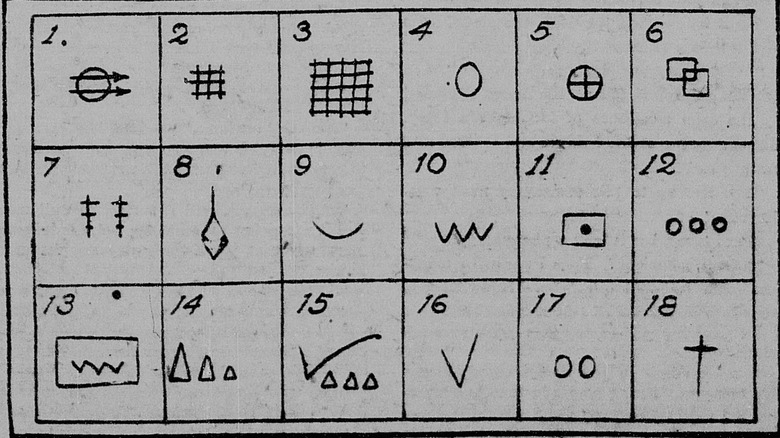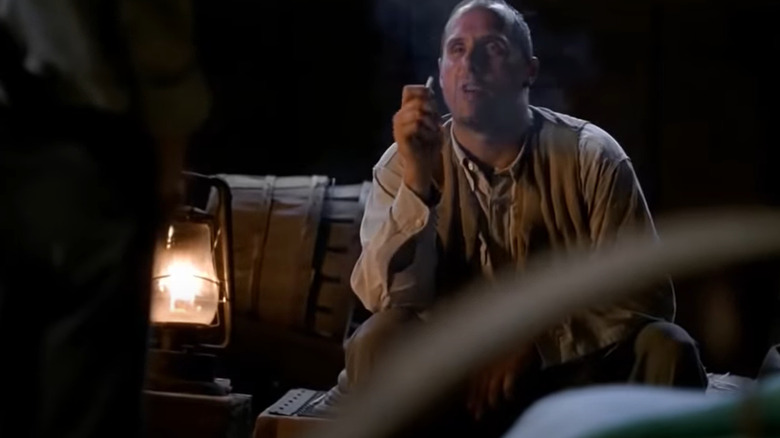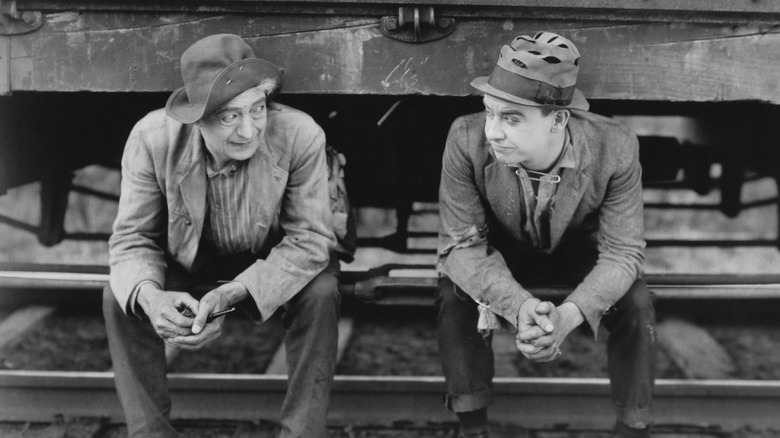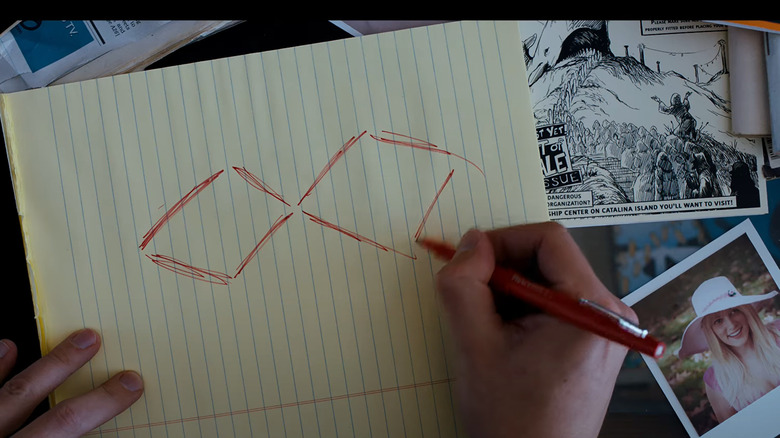The Railroad 'Hobo Code' Explained
The resilience of a people can often be determined not by the advancements of the elite, but by the survival of the poor. Hobo codes, symbols once used by people experiencing homelessness in the 1800s, are a shining example of this type of resilience (via Daily Mail). These cryptic messages emblazoned along the ancient railway have captivated historians, baffled onlookers, and inspired Hollywood movie producers. More importantly, they've helped nearly half a million people survive the harrows of homelessness.
Like the codes, the term "hobo" conveys a cryptic message rooted in ancient misery. It is believed that at the height of this term's popularity in the early 20th century, more than 500,000 people were experiencing the horrors of homelessness, as unemployment and displacement ran rampant through the American West (per National Coalition for the Homeless). There are multiple theories about the word's origin, ranging from acronyms and abbreviations such as "Ho Boy" denoting out-of-work farmers to colloquialisms of the past, such as the informal railroad salutation "Ho, Beau".
Today, the term is largely regarded as negative and mostly unused, except when in reference to a historical context, as is the case with hobo codes, or forms of written communication between the migrant workers. Here's a closer look at all their writings on the walls.
Hobo Codes were pictographs describing the surrounding area
Homelessness in the late 1800s was often a nomadic endeavor. People forced out of their homes by unemployment or crippling poverty looked to the railway to hitch a ride. The Daily Mail reports that in addition to needing to constantly relocate, these individuals were also often illiterate. As is the case in modern times, most hobos were far from lazy, often working long, hard hours in intense, laborious settings (per Collectors Weekly). Theirs were the hands that built the railways they would later need to ride upon.
What they lacked in academic resources they made up for with wit. Knowing their lives depended upon this, they mapped out a series of inconspicuous drawings that could be universally written, read, and understood. These pictographs described the unfamiliar settings newly homeless individuals were entering. Examples of the shorthand are pictured above as they first appeared in a 1921 edition of the New-York Tribune. They told of kindly strangers and dangers on the road. They were instructive, telling newcomers how to behave in the area in order to survive undetected. They were informative, explaining where to go to find work, food, and quiet. They were life-saving. Arguably they still are.
Puzzling as the pictures were, the people who needed them understood
While these hobo codes, alternatively referred to as hobo graffiti, have served as fodder for history buffs and anthropologists for decades, the language was clear for the people who needed to understand it (via Daily Mail). The cryptic code relied heavily on sketchings that were designed to blend into the scenery for people who were not looking for them. This is an ironic parallel in many ways, since so many people from the unhoused community live their lives unseen while in plain sight (per The Guardian).
Examples of commonly used illustrations include a cat to signify a kind lady, two shovels to suggest work opportunities, four horizontal lines symbolizing a housewife who is willing to dole out meals in exchange for household chores, and a simple smiley face to suggest it is safe to sleep in a nearby barn.
Warning symbols, while ominous, were equally simplistic. For example, a circle with two protruding arrows pointing to the right translates to "get out of here fast!" Meanwhile, crossing lines resembling the notorious railroads traversing each town, warn travelers that they are in an unsafe place. The fact that the very people who worked and sometimes lived on freight trains used them as a symbol of lurking danger is very telling.
These homeless hieroglyphics are viewed by some as folklore
It should be duly noted that not everybody believes the shorthand has a rightful place in the history books. According to Atlas Obscura, one particular group of hobo code enthusiasts quickly became skeptics once they took a deeper look into the writing on the walls. This group, a nationally recognized nonprofit established by a father-son duo in 2018, is dedicated to the preservation of historical markings with a vested interest in the hobo era. They call themselves The Historic Graffiti Society and after combing mines and railroad tracks across America, they shockingly report that there might be less historic graffiti from the hobo era to speak of, if there ever was any at all.
"Modern Americans are convinced that hobo signs are authentic history, but the evidence against it definitely outweighs the evidence for it," Charlie Wray of The Historic Graffiti Society told Atlas Obscura. The reason for such skepticism is legit.
When the team first set out to uncover the hidden messages they found a lot of fake material. For example, a seemingly real hobo code was written in a private section of the railroad depot, making it meaningless as a real form of communication and likely the handiwork of a bored railroad worker scrawling signs he'd seen in newspapers or read in hyperbolic texts. Other examples of seemingly real hobo codes have turned out to be equally disappointing.
The cryptic codes were first revealed by freight train hopper Leon Ray Livingston
Indeed, much of the hobo code handbook derives from an exaggerated autobiographical series released by a man born Leon Ray Livingston, better known as A-No. 1, who was arguably the most notorious transient worker of his time (via Mental Floss). A-No. 1 wrote of his journeys through Depression Era homelessness but took a great deal of creative license when divulging the information to his readers. Some have gone so far as to call his autobiographies tall tales that fantasticated the hobo experience through colorful passages of trains and storylines.
Whether his stories were as fanciful as some proclaim or simply unrelatable to people who didn't live life at the crossroads remains to be seen. But just because there's little physical evidence of their existence doesn't mean the codes were completely made up either. In truth, it could mean they were functioning precisely as designed, presenting as a series of temporary symbols fading into the background, meant only for a very specific subset of individuals. According to the Daily Mail, the pictographs were often scribed in temporary mediums such as chalk lines that could easily be washed away.
From TV screens to street corners, these codes continue to leave their mark
Whether these cryptic messages began as fact, fable, or something in between, there's no denying the mark they've left on cultures and communities. According to Paul's Perambulations, the recent noir thriller "Under the Silver Lake" is embedded with hobo code symbolism throughout the film. The Daily Mail reports that these symbols are also a pivotal piece of the plot in an episode of "Mad Men" that aired in 2007.
Just as art imitates life and life imitates art, there is even talk of a modern version of the cryptic symbols creeping into the current world of houseless young people, some of whom are bringing back hobo codes, according to Newsweek. Of course, in this rendition, the railroads and chalk lines are swapped out for tablets, laptops, and smartphones, the walls are virtual, and the messages reflect more modern necessities such as where to access free WiFi and places to plug in your phone, but the means are every bit as essential to survival as they were in the past for those who have no place to call home.





